The crisis in Ukraine has finally made the news in recent weeks. Most of the headlines in the mainstream outlets have focused on the violence in Kyiv. It makes sense. After all, fireballs and burning tires make for sexy pictures. But I’d like to take a look at how things got where they are now and explain what these protests are about. I’m not an expert on this subject, but I’ve been going to Maidan and speaking with people there since the beginning. These are my own views of the situation. I’ve lived in this country for more than two years now, and many of my good friends are Ukrainians, so I look at these events from a specific viewpoint. However, I think it’s important for English speakers to learn about what’s going on and why it matters, so I’ll try to unpack some of the main issues.
This is not about Europe
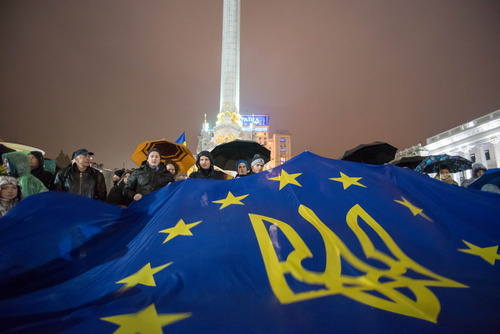
Protesters hold a pro-EU rally on November 22
The Western media still likes to call people on the streets pro-Europe demonstrators. That simply isn’t true. Protests in Ukraine haven’t been about Europe for some time now. Sure, when people first gathered in Independence Square, also known as Maidan Nezalezhnosti (which means “Square of Independence”), in mid-November, most demonstrators were angry over President Viktor Yanukovych’s decision to walk away from an association agreement with the EU that would have brought the country closer to Europe. But the focus on that trade and economic deal was relatively short lived. The media have largely forgotten that pro-EU protests had begun fizzling out by the end of the month.
On November 29, there were maybe a few hundred people still in Kyiv’s Independence Square. Late that night, officers belonging to Berkut, Ukraine’s elite police force, invaded the protest camp, savagely and senselessly beating unarmed protesters and journalists who were still camped out. The next morning, Ukraine awoke to images of students bruised and bloodied by police batons. Those beatings, filmed and uploaded to the Internet, spread like wildfire across social media. From that day on, the protests began to take on a different tone.
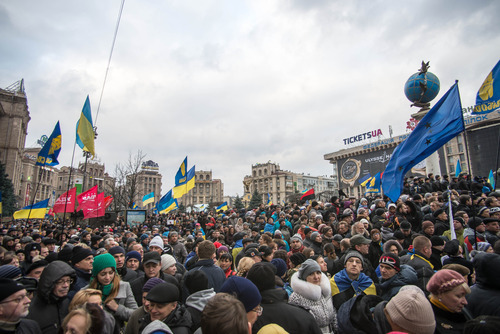
More than 100,000 people flood Kyiv on December 1
That Sunday, hundreds of thousands of Ukrainians, enraged that their government could allow such brutal violence against peaceful demonstrators, flooded central Kyiv. People hopped on buses in cities across the country—from Lviv to Kharkov—to head to the capital and demand reforms and apologies. Authorities explained that they sent in officers because they needed to clear Independence Square to erect the annual New Year tree. The government then fired the city’s police chief, a move seen as little more than a token gesture.
The government’s failure to address the demands of the masses on the streets, compounded by Yanukovych’s arrogance and dismissiveness, served only to embolden the movement. Protesters from all corners of the country set up permanent tents, built a stage smack in the center of the square, and dug in for a long haul. The partially built tree, the government’s excuse for the beatings, became a powerful symbol for the growing movement.
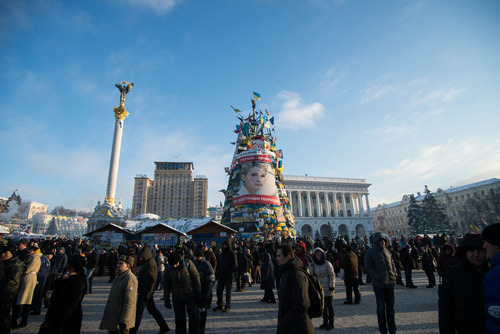
The New Year tree, now draped in protest banners, is a symbol of anger toward state violence and oppression
Changing dynamics
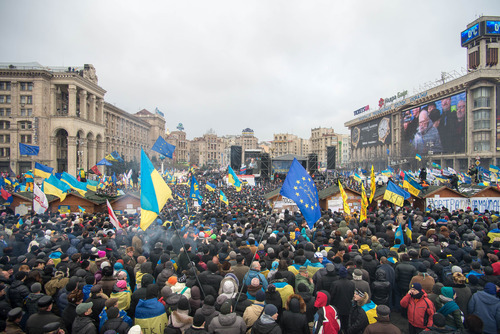
Hundreds of thousands rally on Maidan on December 8
The demands of protesters in the early weeks were manifold—many wanted Yanukovych to change his mind about the EU agreement, others wanted reforms to combat corruption in the government and especially the police force, some demanded the release of jailed former Prime Minister Yulia Tymoshenko, and others simply wanted to see the president gone.
Skip ahead a few weeks. Reports spread of protesters missing under mysterious circumstances. Protesters and journalists also began identifying thugs paid by the government, known as Tituski, who were repeatedly spotted trying to provoke violence. By the end of December, calls for change grew louder and more urgent.
On January 16, the Ukrainian parliament shocked the nation by passing a slew of authoritarian laws aimed at punishing peaceful protesters. The laws were passed unexpectedly by a show of hands in parliament, taking opposition lawmakers and people on the streets by surprise. Among the new rules, the package bill outlawed demonstrators from wearing protective headgear and sheltered police from punishment for harsh riot-control tactics. It also banned unauthorized mass gatherings and required journalists and so-called “foreign agents” to register with the government. Violations would lead to tough prison sentences.
Violence breaks out

Protesters throw rocks at police on January 20
After the law was passed, a mass of enraged protesters and far-right groups marched from Maidan toward the main government buildings on Hrushevskoho Street. They were met by a line of riot police who pushed them back. That is when the violence finally kicked off. Protesters lit police buses ablaze and hurled rocks at police and Berkut, who responded with tear gas, flashbangs, and water cannons.
The clashes continued for several days. On January 22, Berkut officers shot and killed two protesters—the first direct casualties of the conflict. For many people, this was the final turning point. By this time, the EU flags that had once dotted Maidan had disappeared, and chants of “police are with the people” turned to chants of “murderers” and “shame.” Hundreds of protesters and police were injured in the worst hours of violence. Reports soon spread that Berkut were intentionally targeting journalists, shooting them with rubber bullets and beating them with batons.
Police arrested scores of demonstrators, while many others disappeared. Some, including Dmytro Bulatov, a high-profile leader of the related Automaidan movement, reappeared days later claiming they were abducted and tortured. One of those kidnapped, Yuri Verbitsky, was found bloody and frozen to death in the woods.
These terrifying human rights abuses, widely believed to have been carried out with support of the government, have only fueled anger on the streets. Many of those who were once ambivalent toward the protest are now involved in the movement, providing clothes and food to those on the front lines and pledging their support for demonstrators. Every act of state-sanctioned violence has widened the base of the movement, convincing more and more Ukrainians that the whole government needs to go.
A weak and disorganized opposition

Opposition leader Vitali Klitschko tries to herd protesters back to Maidan on December 1
A common mistake is to confuse the opposition with the protest movement. They are not the same thing. The three main opposition leaders—Arseniy Yatsenyuk, who now leads Tymoshenko’s Fatherland Party, Vitali Klitschko, a former boxer who leads the pro-West UDAR party, and Oleh Tyahnybok, leader of the right-wing nationalist Svoboda party—have all jumped on the protest stage on Maidan to blast the government and jockey for support from protesters. They have been regular fixtures of the protest since the beginning, but they have been unable to effectively lead the movement. Deep distrust of all three politicians pervades the protests.
Radical groups, including those operating under the blanket far-right organization known as Pravvy Sektor, have grown in strength and popularity, orchestrating some of the take-overs of government buildings and spreading information about police activity. Those groups and their sympathizers have worried some Western observers, although their role in the movement shouldn't be over exaggerated.
Next steps
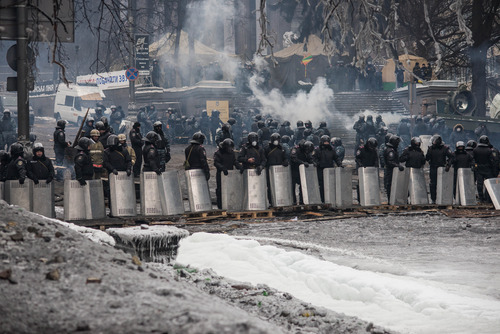
Riot police face off with protesters on Hrushevskoho Street on January 29
Cracks in the regime are showing. Yanukovych, who for more than two months refused to budge a single inch, is beginning to show his growing weakness. Last week, he offered to replace widely reviled Prime Minister Mykola Azarov with Arseniy Yatsenyuk and to appoint Vitali Klitschko deputy prime minister. The opposition refused, knowing well that accepting the deal would further isolate them from the protest movement.
Azarov submitted his resignation a few days later, and the parliament repealed many of the hated anti-protest laws. But those gestures aren’t enough. The barricades on Hrushevskoho are higher than ever, and no one on Maidan is going anywhere anytime soon. The government must undergo more radical change. Berkut and the entire Ministry of the Interior need to be reformed. Yanukovych needs to call early elections. The situation is tense. It's unclear what the government will do next—whether it will again use force against the protesters, or whether it will negotiate a peaceful end to the crisis.
What’s happening on the streets of Kyiv, and now on the streets of cities across the country, is not the result of one action by the government. People are fed up. They are sick of corruption in government and law enforcement. They are sick of economic and political mismanagement at every level. They are shocked and outraged at the level of violence carried out by the state. What’s happening in Ukraine right now is decades of anger and frustration boiling over. It’s not about Europe. It's not about the West vs. the East. It’s about Ukraine.
All photos here were taken by me, Chris Collison.
No comments:
Post a Comment